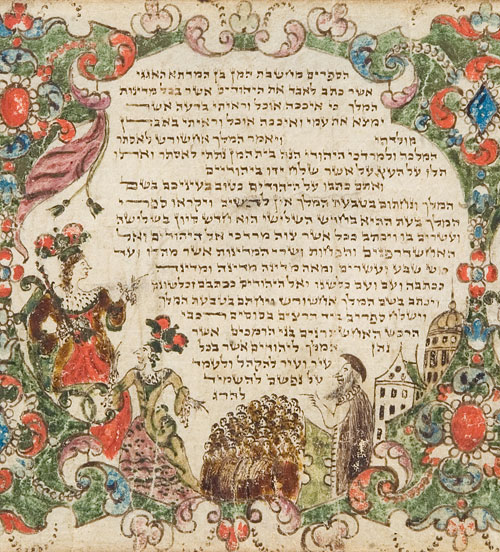Opening Question: Who are some of the worst enemies that the Jewish people has faced? What risks have they posed to Jewish survival?
2. Introduction to Daniel Chapters 7-12:
a. Apocalyptic Literature and Apocalypses
b. The Contents of Chapters 7-12: Apocalyptic Visions
3. Introduction to Chapter 7: The Dream of Nebuchadnezzar (The Great Statue -
The Four Kingdoms) (Chapter 2) revisited
4. Questions for Chapter 7
5. Our Text: Chapter 7 - The Four Beasts
6. Discussion and Commentaries
7. Summary and Next Class
2a. Apocalyptic Literature and Apocalypses
John H. Hayes, An Introduction to Old Testament Study
“The book of Daniel occupies a unique position in the Old Testament: it is the only work which belongs to the category of apocalyptic literature. The term ‘apocalypse’ is a Greek word meaning ‘revelation’ which appears as the first word in a New Testament book—The Revelation to John. From its appearance there, the term has been employed to designate ‘literary compositions which resemble the book of Revelation, i.e., secret disclosures about the end of the world and the heavenly state.’” (p. 365)
"…the structure of apocalypses:…the matter is put into the mouth of a person of primeval times, like Noah, or Lamech, or Enoch, or at least one of late biblical or exilic times, like Baruch, Daniel or Ezra; this person of ancient times is represented as having received a vision, being taken up into a heavenly world, and shown mysterious things which then have to be explained to him. The explanation often comes from an angel…” (pp. 365-6)
“The Jewish community, like many other peoples during the Persian and Hellenistic periods, was dominated by powers distant and beyond its control. Self-determination was limited and always precarious. … Between Alexander’s death and Antiochus IV Epiphanes, Jerusalem was captured by foreign armies on at least ten occasions.” (p. 386)
“Endurance in the present and ultimate hope in God must have frequently seemed the only sensible postures when confronted with evil so broad and diffuse, so embodied in powers before whom men of faith were powerless. “ (p. 387)
Paul D. Hanson, “Apocalypses and Apocalypticism,” Anchor Bible Dictionary
"A group headed by J. J. Collins expanded on earlier studies of the genre apocalypse by analyzing all of the texts classifiable as apocalypses from the period 250 B.C.E. to 250 c.e. and concluded with this definition: "'Apocalypse' is a genre of revelatory literature with a narrative framework, in which a revelation is mediated by an otherworldly being to a human recipient, disclosing a transcendent reality which is both temporal, insofar as it envisages eschatological salvation, and spatial, insofar as it involves another, supernatural world" (Collins 1979: 9). (I:279b)
Setting and Function. "Though the degree to which .... apocalypses preserve traces of their historical setting varies, it is evident in general terms that they all reflect a situation of crisis and aim at offering assurance of salvation to those alienated from the power structures of this world and suffering for their religious convictions. Daniel envisions the imminent destruction of Antiochus IV and the conferral of the kingdom on the "saints of the Most High." (I:280a)
Note the languages of these visions
- Chapter 7 Aramaic. The four beasts (Reign of Belshazzar, year 1)
- Chapter 8 Hebrew. The ram and the he-goat (Reign of Belshazzar, year 3)
- Chapter 9 Hebrew. Jeremiah’s prophecy of seventy years (Reign of Darius, year 1)
- Chapter 10 Hebrew. Vision of the last days, part 1 (Reign of Cyrus, year 3) Daniel is strengthened by an angelic being
- Chapter 11 Hebrew. Vision of the last days, part 2: History of the Seleucids
- Chapter 12 Hebrew. Vision of the last days, part 3: The End of the Days
(The Great Statue -The Four Kingdoms) (Chapter 2) revisited
Reviewing: In the Eye of the Artist: Rembrandt on chapter 2
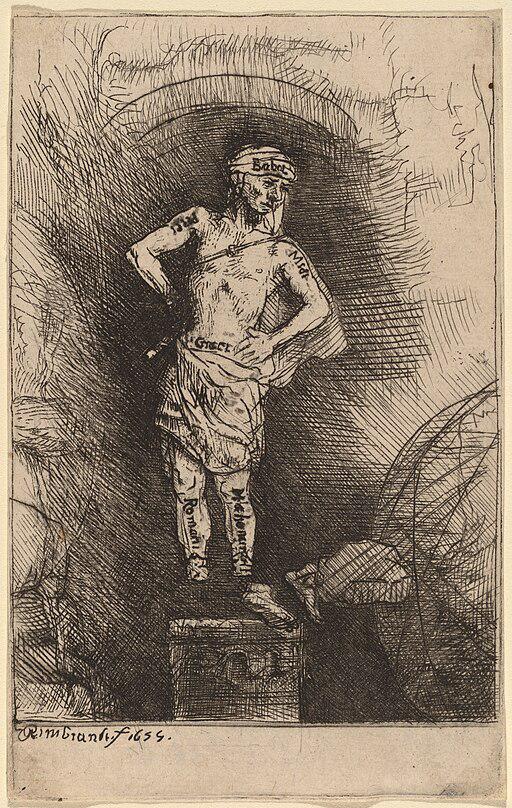
Rembrandt van Rijn (1606-1669), The Image Seen by Nebuchadnezzar, 1655
Rembrandt reflects this identification of the four kingdoms:
1. Babylonia
2. Media - Persia
3. Greece
4. Rome - Islam
For Jews living in Christendom, kingdom 4. was regularly associated with Edom = Rome = Christendom (See Rashi on ch. 7). For Jews from Muslim lands, kingdom 4 was often associated with Ishmael = Islam (See ibn Ezra on ch. 7).
| Kingdom | Chapter 2 | Chapter 7 | Chapter 8 | Named Kings |
| Babylonia | Head of Gold | Lion | Nebuchadnezzar (ch 2) and Belshazzar (ch 7) | |
| Media | Breast and arms of Silver | Bear | Darius the Mede (chs. 6, 9) | |
| Persia | Belly and thighs of Bronze | Leopard | Ram | Cyrus (ch 10) |
| Macedonia or Greece | Feet of Iron and Clay | The Fourth Beast | He-Goat | (Antiochus IV, alluded to in chs 7 and 11) |
- How do you understand the prophecies in this chapter?
- How do you understand the references to winds (v. 1 and elsewhere), sea (v. 1 and elsewhere), and clouds (v. 13)?
- How do you understand the animal imagery in ch. 7 - wings, teeth, etc.?
- What do you make of the image of the Ancient One/עתיק יומין/`Atiq yomin (vv. 9 and following)
- How do you understand the 'one in human likeness'/כבר אנש/KeVar Enash (v. 13)
- How do you understand the 'holy ones of the Most High'/קדישי עליונין/Qaddishei `Elyonin (v. 18) and 'the people of the holy ones of the Most High'/עם קדישי עליונין/`Am Qaddishei `Elyonin (v.27)?
- What is meant by 'a time, times, and half a time'? (v. 25)
- What do you think is the basic message of ch. 7?
(א) בִּשְׁנַ֣ת חֲדָ֗ה לְבֵלְאשַׁצַּר֙ מֶ֣לֶךְ בָּבֶ֔ל דָּנִיֵּאל֙ חֵ֣לֶם חֲזָ֔ה וְחֶזְוֵ֥י רֵאשֵׁ֖הּ עַֽל־מִשְׁכְּבֵ֑הּ בֵּאדַ֙יִן֙ חֶלְמָ֣א כְתַ֔ב רֵ֥אשׁ מִלִּ֖ין אֲמַֽר׃ (ב) עָנֵ֤ה דָנִיֵּאל֙ וְאָמַ֔ר חָזֵ֥ה הֲוֵ֛ית בְּחֶזְוִ֖י עִם־לֵֽילְיָ֑א וַאֲר֗וּ אַרְבַּע֙ רוּחֵ֣י שְׁמַיָּ֔א מְגִיחָ֖ן לְיַמָּ֥א רַבָּֽא׃
Daniel records a dream
(1) In the first year of King Belshazzar of Babylon, Daniel saw a dream and a vision of his mind in bed; afterward he wrote down the dream. Beginning the account, (2) Daniel related the following:
“In my vision at night, I saw the four winds of heaven stirring up the great sea.
(ג) וְאַרְבַּ֤ע חֵיוָן֙ רַבְרְבָ֔ן סָלְקָ֖ן מִן־יַמָּ֑א שָׁנְיָ֖ן דָּ֥א מִן־דָּֽא׃ (ד) קַדְמָיְתָ֣א כְאַרְיֵ֔ה וְגַפִּ֥ין דִּֽי־נְשַׁ֖ר לַ֑הּ חָזֵ֣ה הֲוֵ֡ית עַד֩ דִּי־מְּרִ֨יטוּ (גפיה) [גַפַּ֜הּ] וּנְטִ֣ילַת מִן־אַרְעָ֗א וְעַל־רַגְלַ֙יִן֙ כֶּאֱנָ֣שׁ הֳקִימַ֔ת וּלְבַ֥ב אֱנָ֖שׁ יְהִ֥יב לַֽהּ׃
Beast #1
(3) Four mighty beasts different from each other emerged from the sea. (4) The first was like a lion but had eagles’ wings. As I looked on, its wings were plucked off, and it was lifted off the ground and set on its feet like a man and given the mind of a man.
Beast ##2-3
(5) Then I saw a second, different beast, which was like a bear but raised on one side, and with three fangs in its mouth among its teeth; it was told, ‘Arise, eat much meat!’ (6) After that, as I looked on, there was another one, like a leopard, and it had on its back four wings like those of a bird; the beast had four heads, and dominion was given to it.
Beast #4
(7) After that, as I looked on in the night vision, there was a fourth beast—fearsome, dreadful, and very powerful, with great iron teeth—that devoured and crushed, and stamped the remains with its feet. It was different from all the other beasts which had gone before it; and it had ten horns. (8) While I was gazing upon these horns, a new little horn sprouted up among them; three of the older horns were uprooted to make room for it. There were eyes in this horn like those of a man, and a mouth that spoke arrogantly.
Judgment by the Ancient of Days
(9) As I looked on,
Thrones were set in place,
And the Ancient of Days took His seat.
His garment was like white snow,
And the hair of His head was like lamb’saOr “clean.” wool.
His throne was tongues of flame;
Its wheels were blazing fire. (10) A river of fire streamed forth before Him;
Thousands upon thousands served Him;
Myriads upon myriads attended Him;
The court sat and the books were opened. (11) I looked on. Then, because of the arrogant words that the horn spoke, the beast was killed as I looked on; its body was destroyed and it was consigned to the flames. (12) The dominion of the other beasts was taken away, but an extension of life was given to them for a time and season.
The One Like a Human Being
(13) As I looked on, in the night vision,
One like a human being
Came with the clouds of heaven;
He reached the Ancient of Days
And was presented to Him. (14) Dominion, glory, and kingship were given to him;
All peoples and nations of every language must serve him.
His dominion is an everlasting dominion that shall not pass away,
And his kingship, one that shall not be destroyed.
Daniel seeks an angelic interpretation of his dream
(15) As for me, Daniel, my spirit was disturbed within me and the vision of my mind alarmed me. (16) I approached one of the attendants and asked him the true meaning of all this. He gave me this interpretation of the matter: (17) ‘These great beasts, four in number [mean] four kingdoms will arise out of the earth; (18) then holy ones of the Most High will receive the kingdom, and will possess the kingdom forever—forever and ever.’
Daniel seeks an angelic interpretation of his dream: The Fourth Beast
(19) Then I wanted to ascertain the true meaning of the fourth beast, which was different from them all, very fearsome, with teeth of iron, claws of bronze, that devoured and crushed, and stamped the remains; (20) and of the ten horns on its head; and of the new one that sprouted, to make room for which three fell—the horn that had eyes, and a mouth that spoke arrogantly, and which was more conspicuous than its fellows. (21) (I looked on as that horn made war with the holy ones and overcame them, (22) until the Ancient of Days came and judgment was rendered in favor of the holy ones of the Most High, for the time had come, and the holy ones took possession of the kingdom.)
The angelic interpretation
(23) This is what he said: ‘The fourth beast [means]—there will be a fourth kingdom upon the earth which will be different from all the kingdoms; it will devour the whole earth, tread it down, and crush it. (24) And the ten horns [mean]—from that kingdom, ten kings will arise, and after them another will arise. He will be different from the former ones, and will bring low three kings. (25) He will speak words against the Most High, and will harass the holy ones of the Most High. He will think of changing times and laws, and they will be delivered into his power for a time, times, and half a time. [NJPS Translators' Note: I.e., a year, two years, and a half a year.] (26) Then the court will sit and his dominion will be taken away, to be destroyed and abolished for all time. (27) The kingship and dominion and grandeur belonging to all the kingdoms under Heaven will be given to the people of the holy ones of the Most High. Their kingdom shall be an everlasting kingdom, and all dominions shall serve and obey them.’”
Daniel concludes his record and reacts to his dream as interpreted
(28) Here the account ends.
I, Daniel, was very alarmed by my thoughts, and my face darkened; and I could not put the matter out of my mind.
6a. Reactions - Discussion
6b. Beasts - in the eye of Mesopotamian artisans and a European artist
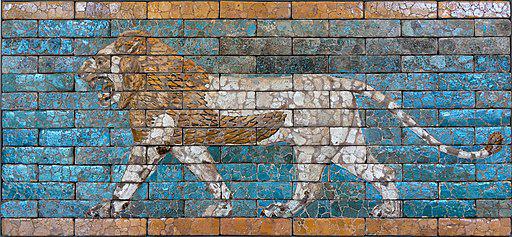
Passing lion, brick panel from the Procession Way which ran from the Marduk temple to the Ishtar Gate and the Akitu Temple. Glazed terracotta, reign of Nebuchadrezzar II (605 BC–562 BC), Babylon (Iraq). At the Louvre.
https://commons.wikimedia.org/wiki/File:Passing_lion_Babylon_AO21118.jpg
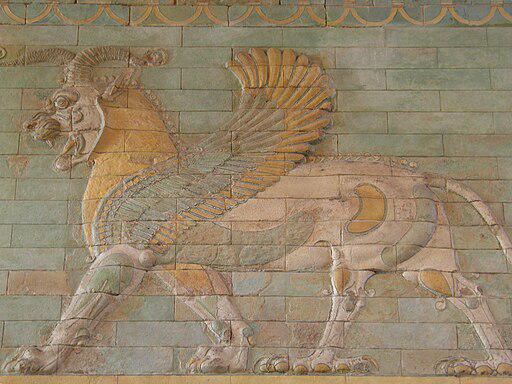
Frieze of Griffins, circa 510 BC, Apadana, west courtyard of the palace, Susa, Iran Susa, Iran, Louvre Museum (12251831946).jpg
“The artists of the Achaemenian period inherited a pictorial vocabulary rich in mythological creatures. The griffin-lion, often represented at Susa, is here pictured on an element of architectural decoration from the palace of King Darius I the Great (522-486 BC). It featured here alongside the lion and the winged bull passant on reliefs made with bricks, with or without colors.”
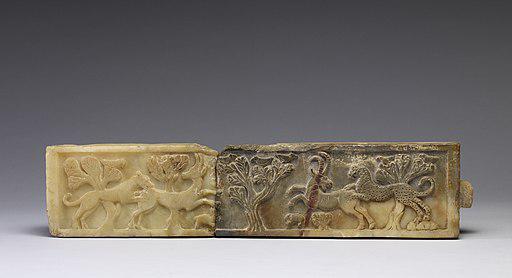
A Lion and a Leopard Attacking Animals (5th c. BCE)
On the left side of this relief, an Asiatic lion attacks a gazelle, while a rabbit tries to jump away from the gazelle's forelegs. On the right, an Arabian leopard jumps down from rocks onto the back of an ibex; a small rodent flees the hoofs of the ibex. Birds in the branches of acacia trees observe the two scenes.
https://commons.wikimedia.org/wiki/File:South_Arabian_-_A_Lion_and_a_Leopard_Attacking_Animals_-_Walters_2171.jpg. Walters Art Museum (Baltimore) Public domain, via Wikimedia Commons
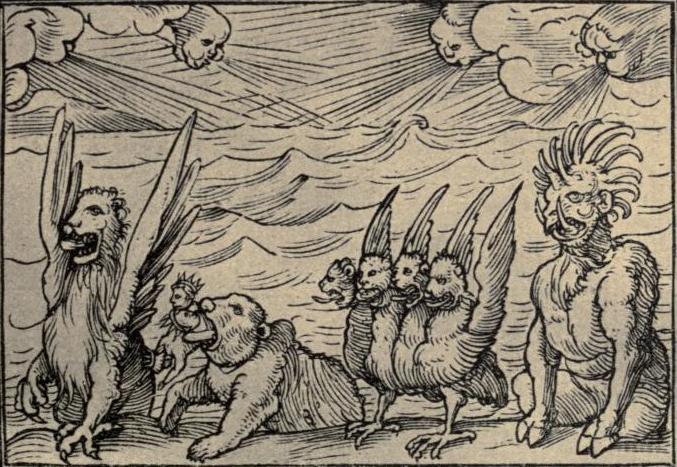
Hans Holbein the Younger (1497-1543): Hans Holbein the Younger, His Old Testament illustrations, Dance of death and other woodcuts. London: William Heinemann, 1912.
Daniel's vision of the four beasts (Daniel 7).
Winds and Sea
(2) Daniel related the following:
“In my vision at night, I saw the four winds of heaven stirring up the great sea.
(2) the earth being unformed and void, with darkness over the surface of the deep and a wind from [Others “the spirit of”] God sweeping over the water—
Who is the Lion?
(4) The first was like a lion but had eagles’ wings. As I looked on, its wings were plucked off, and it was lifted off the ground and set on its feet like a man and given the mind of a man.
(6) Set up a signpost: To Zion.
Take refuge, do not delay!
For I bring evil from the north,
And great disaster. (7) The lion [=Babylonia] has come up from its thicket:
The destroyer of nations has set out,
Has departed from its place,
To make your land a desolation;
Your cities shall be ruined,
Without inhabitants.
Who is Beast #2 (Bear)?
(11) Polish the arrows,
Fill the quivers!
GOD has roused the spirit of the kings of Media,
For the divine plan against Babylon is to destroy her.
This is GOD’s vengeance,
Vengeance for the holy temple.
(9) As I looked on,
Thrones were set in place,
And the Ancient of Days took His seat.
His garment was like white snow,
And the hair of His head was like lamb’s wool.
His throne was tongues of flame;
Its wheels were blazing fire. (10) A river of fire streamed forth before Him;
Thousands upon thousands served Him;
Myriads upon myriads attended Him;
The court sat and the books were opened.
(19) But [Micaiah] said, “I call upon you to hear the word of GOD! I saw GOD seated upon a throne, with all the host of heaven standing in attendance to the right and to the left.
(טז) אָ֧ז נִדְבְּר֛וּ יִרְאֵ֥י יְהֹוָ֖ה אִ֣ישׁ אֶל־רֵעֵ֑הוּ וַיַּקְשֵׁ֤ב יְהֹוָה֙ וַיִּשְׁמָ֔ע וַ֠יִּכָּתֵ֠ב סֵ֣פֶר זִכָּר֤וֹן לְפָנָיו֙ לְיִרְאֵ֣י יְהֹוָ֔ה וּלְחֹשְׁבֵ֖י שְׁמֽוֹ׃
(16) In this vein have those who revere GOD been talking to one another. GOD has heard and noted it, and a scroll of remembrance has been written at God’s behest concerning those who revere GOD and esteem the holy name.
Who is One Like a Human Being? Who are the Holy Ones of the Most High?
(13) As I looked on, in the night vision,
One like a human being
Came with the clouds of heaven;
He reached the Ancient of Days
And was presented to Him.
(18) then holy ones of the Most High will receive the kingdom, and will possess the kingdom forever—forever and ever.’
It seems plausible...that the author who wrote about the 'one in human likeness,' symbolizing 'the holy ones of the Most High,' who will receive 'the kingdom and the dominion and the grandeur of all the kingdoms uner heaven, and whose 'royal rule will last forever' (7:27), had in mind the same ones (i.e. the loyal Jews) who are symbolized by 'the stone that struck the statue and became a great mountain and filled all the earth' (2:34-35). (p 100)
Louis F. Hartman, Anchor Bible: Daniel (comment to 7:13-14,18,27)
In Daniel 7 the symbolic manlike figure has no messianic meaning expert perhaps as connected with messianism in the broad sense, i.e. with God's plan of salvation for his Chosen People. But in later Jewish apocalyptic literature (the Parables of Enoch and II Esdras) the term 'son of man' soon shifted from a mere personification to a real person, the Messiah. (p. 219)
Lawrence Wills, Jewish Study Bible, comment to 7:13-14. (Compare J. J. Collins in Harper Collins Study Bible
Human being... For the author it most likely represents a heavenly figure who will exercise judgment, perhaps Michael (see 10:13 n.)
(ז) ... ויאמר רבי ישועה: כי זה כבר אנש הוא המשיח. ונכון דבר רק הוא עם הקדש שהם ישראל.
Rabbi Yeshuah said that the 'one like a man' is the Messiah. He spoke well, except that this refers to the holy people who are Israel.
(יג) וְשַׂ֣ר ׀ מַלְכ֣וּת פָּרַ֗ס עֹמֵ֤ד לְנֶגְדִּי֙ עֶשְׂרִ֣ים וְאֶחָ֣ד י֔וֹם וְהִנֵּ֣ה מִֽיכָאֵ֗ל אַחַ֛ד הַשָּׂרִ֥ים הָרִאשֹׁנִ֖ים בָּ֣א לְעׇזְרֵ֑נִי וַאֲנִי֙ נוֹתַ֣רְתִּי שָׁ֔ם אֵ֖צֶל מַלְכֵ֥י פָרָֽס׃
(13) However, the prince of the Persian kingdom opposed me for twenty-one days; now Michael, a prince of the first rank, has come to my aid, after I was detained there with the kings of Persia.
(18) Grant Your help to the man at Your right hand,
the one/בן-אדם/ben-adam You have taken as Your own. (19) We will not turn away from You;
preserve our life that we may invoke Your name. (20) O LORD, God of hosts, restore us;
show Your favor that we may be delivered.
(ו) וְאַתֶּ֧ם תִּהְיוּ־לִ֛י מַמְלֶ֥כֶת כֹּהֲנִ֖ים וְג֣וֹי קָד֑וֹשׁ אֵ֚לֶּה הַדְּבָרִ֔ים אֲשֶׁ֥ר תְּדַבֵּ֖ר אֶל־בְּנֵ֥י יִשְׂרָאֵֽל׃
(6) but you shall be to Me a kingdom of priests and a holy nation.’ These are the words that you shall speak to the children of Israel.”
What is the War against the Holy Ones?
(21) (I looked on as that horn made war with the holy ones and overcame them,
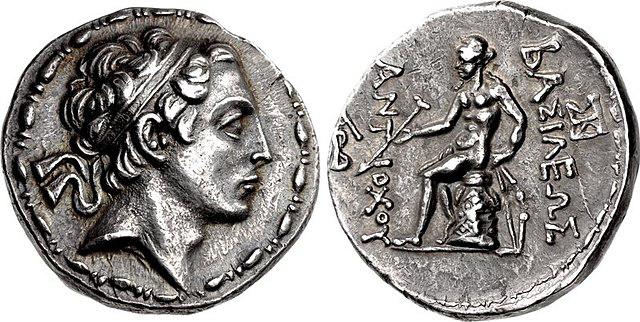
By Classical Numismatic Group, Inc. http://www.cngcoins.com, CC BY-SA 2.5, https://commons.wikimedia.org/w/index.php?curid=73629351
SELEUCID EMPIRE. Antiochos IV Epiphanes. 175-164 BC. AR Tetradrachm (27mm, 17.08 g, 12h). Antioch in Persis mint.
(מב) ויכתוב המלך אנטיוכוס אל כל מדינות מלכותו לאמור: אך תורה אחת וחוקה אחת לכל יושבי ארצנו.
(מג) ויעזבו כל עמי הארץ את חוקותיהם ויעשו כאשר ציוה אותם המלך.
(מד) ויאותו גם רבים מבני ישראל ויזבחו לאלילים ויחללו את השבת.
(מה) וישלח המלך ספרים ביד הרצים אל ירושלים ולכל ערי יהודה, ויצוום ללכת בדרכי גויי הארץ.
(מו) לבלתי הקריב עוד עולה ומנחה בקודש, ולבלתי הסך נסך לה', ולהפר את השבתות ואת המועדים.
(מז) לחלל את המקדש ואת הכוהנים, ולהקים במות ובתים לאלילים, ולהקריב בשר חזיר וכל בהמה טמאה.
(מח) ויצווה לבלתי המול להם כל זכר, ולשקץ את נפשותם בכל דבר פיגול, להעבירם מחוקות אלוהים ולשנות את דרכם.
(מט) וכל איש אשר ימרה את פי המלך - מות יומת.
(נ) אלה הדברים אשר העביר בכל מדינות מלכותו, ויפקד פקידים על הארץ לעשותם. וישלח לכל ערי יהודה, ויצוום לזבוח זבח.
(נא) וייסוגו רבים ממצות ה' וייצמדו לגויים, ותשחת כל הארץ לפניהם.
(נב) ויהי הם נוגשים את העם, ויתחבאו במערות ובכל מקום אשר מצאו שם מפלט.
(נג) ויהי בשנת מאה וארבעים וחמש, בחמשה עשר יום לחודש כסלו, ויקימו שיקוץ משומם על מזבח ה', ויבנו במות בכל ערי יהודה מסביב.
(נד) ויזבחו ויקטרו בחוצות העיר ולפני פתחי ביתם, ויקרעו את ספרי תורת ה' לקרעים, וישרפו אותם באש.
(נה) וכל אשר נמצא אתו ספר ברית ה', וכל השומר את פי ה', היכו לפי חרב כאשר ציוה המלך.
(נו) כמשפט הזה עשו לבני ישראל מדי חודש בחודשו בהיקבץ העם אל הערים.
(נז) ובחמישה ועשרים יום לחודש זבחו את זבחיהם על הבמה אשר הקימו נוכח מזבח ה'.
(נח) והנשים אשר מלו את בניהן הומתו על פי המלך.
(נט) את העוללים תלו בצווארם, ואת המלים אותם הרגו בחרב ויבוזו את בתיהם.
(ס) ורבים מבני ישראל דבקו בתורת ה' ויישמרו מאכול כל דבר טמא.
(סא) ויבחרו את המוות משקץ את נפשותם, ומחלל את ברית ה', וימותו.
(סב) ויהי קצף גדול על כל ישראל.
(42) Moreover king Antiochus wrote to his whole kingdom, that all should be one people,
(43) And every one should leave his laws: so all the heathen agreed according to the commandment of the king.
(44) Yea, many also of the Israelites consented to his religion, and sacrificed unto idols, and profaned the sabbath.
(45) For the king had sent letters by messengers unto Jerusalem and the cities of Juda that they should follow the strange laws of the land,
(46) And forbid burnt offerings, and sacrifice, and drink offerings, in the temple; and that they should profane the sabbaths and festival days:
(47) And pollute the sanctuary and holy people: Set up altars, and groves, and chapels of idols, and sacrifice swine’s flesh, and unclean beasts:
(48) That they should also leave their children uncircumcised, and make their souls abominable with all manner of uncleanness and profanation: To the end they might forget the law, and change all the ordinances.
(49) And whosoever would not do according to the commandment of the king, he said, he should die.
(50) In the selfsame manner wrote he to his whole kingdom, and appointed overseers over all the people, commanding the cities of Juda to sacrifice, city by city.
(51) Then many of the people were gathered unto them, to wit every one that forsook the law; and so they committed evils in the land;
(52) And drove the Israelites into secret places, even wheresoever they could flee for succour.
(53) Now the fifteenth day of the month Casleu, in the hundred forty and fifth year [of the Seleucid Era], they set up the abomination of desolation upon the altar, and builded idol altars throughout the cities of Juda on every side;
(54) And burnt incense at the doors of their houses, and in the streets. And when they had rent in pieces the books of the law which they found, they burnt them with fire.
(55) And whosoever was found with any the book of the testament, or if any committed to the law, the king’s commandment was, that they should put him to death.
(56) Thus did they by their authority unto the Israelites every month, to as many as were found in the cities.
(57) Now the five and twentieth day of the month they did sacrifice upon the idol altar, which was upon the altar of God.
(58) At which time according to the commandment they put to death certain women, that had caused their children to be circumcised.
(59) And they hanged the infants about their necks, and rifled their houses, and slew them that had circumcised them.
(60) Howbeit many in Israel were fully resolved and confirmed in themselves not to eat any unclean thing.
(61) Wherefore the rather to die, that they might not be defiled with meats, and that they might not profane the holy covenant: so then they died
(62) And there was very great wrath upon Israel.
(נא) ויהי ביום החמישי ועשרים לחדש התשיעי הוא כסלו, בשנת שמונה וארבעים ומאה, וישכימו בבוקר ויעלו עולות על המזבח החדש כמשפט.
(51) Now on the five and twentieth day of the ninth month, which is called the month Casleu, in the hundred forty and eighth year, they rose up betimes in the morning, And offered sacrifice according to the law upon the new altar of burnt offerings, which they had made.
(25) He will speak words against the Most High, and will harass the holy ones of the Most High. He will think of changing times and laws, and they will be delivered into his power for a time, times, and half a time.
...the persecution in the strict sense, which began with the desecration of the temple by Epiphanes (I. Macc. 1:54 [or 53]) on Chislev 15, 145 S.E. (= 6 December 167 B.C.) and ended with the reconquest and purification of the temple by Judas Maccabee (I Macc. 4:52 [or 51]) on Chislev 25, 148 S.E. (=14 December 165 B.C.), lasted at the most, three years and eight days...
Lawrence M. Wills, Jewish Study Bible, Introduction to Daniel, p. 1636
Because of the detailed nature of apocalyptic timetables, the dating of at least the last chapters of Daniel can be established precisely. Scholars consider the predictions in this book, as in other apocalypses, to be prophecies after the fact, purportedly written down centuries earlier and kept secret in order to give credence to other predictions about the end of history. [DR: See chapters 10-12]. ... The predictions are detailed and accurate until near the end of the Maccabean revolt in 164.
- Class 7
- Summary of Chapter 8 Hebrew. The ram and the he-goat
- Chapter 9 Hebrew. Jeremiah’s prophecy of seventy years
A time for crying, a time for dancing (Kohelet/Ecclesiastes 3:4)
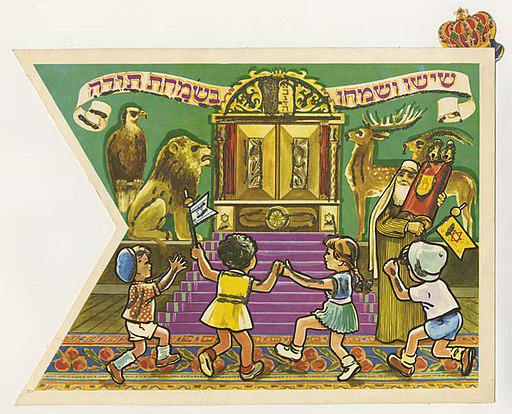
Simchat Torah Flag, circa 1950s-1960s. Center for Jewish History, NYC, No restrictions, via Wikimedia Commons




